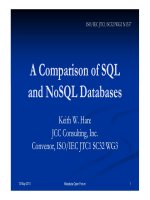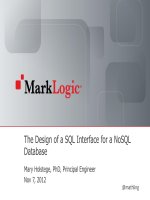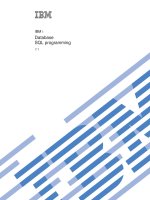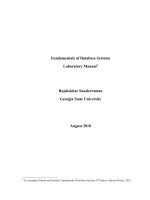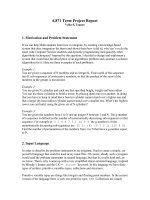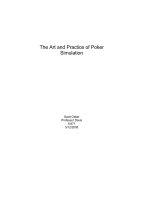TÀI LIỆU - Cao Học Khóa 8 - ĐH CNTT 3. a
Bạn đang xem bản rút gọn của tài liệu. Xem và tải ngay bản đầy đủ của tài liệu tại đây (1.33 MB, 78 trang )
Database Tuning and Self-Tuning
Dr.-Ing. Eike Schallehn
OvG Universität Magdeburg
Fakultät für Informatik
Institut für Technische und Betriebliche Informationssysteme
2012
Overview
Database Tuning:
What are issues, basic principles, and common techniques for
optimizing the performance of a database system?
Database Self-Tuning:
What are current approaches to automate the database tuning
process and what techniques can be used for a possible full
automization in the future?
Schallehn (FIN/ITI)
Database Tuning and Self-Tuning
2012
2 / 78
Literature: Database Tuning
Dennis Shasha: Database Tuning - A Principled Approach,
Prentice-Hall 1992
According tutorial at VLDB 2002
According tutorial at SIGMOD 2002
According lecture slides available at
/>
Sitansu S. Mittra: Database Performance Tuning and
Optimization, Springer Verlag 2002
Michael J. Corey, Michael Abbey, Daniel J. Dechichio: Tuning
Oracle, Oracle Press 1994
Gunter Saake, Andreas Heuer: Datenbanken:
Implementierungstechniken, MITP-Verlag Bonn, 1999
Klemens Böhm: Vorlesung Datenbankimplementierung und
-Tuning, Kapitel 11: Tuning relationaler Datenbanken
Schallehn (FIN/ITI)
Database Tuning and Self-Tuning
2012
3 / 78
Literature: Database Self-Tuning
Surajit Chaudhuri, Vivek Narasayya: Self-Tuning Database
Systems: A Decade of Progress, VLDB 2007, Ten Year Best
Paper Award
Kai-Uwe Sattler: Self-Tuning in DBMS: Techniken und aktuelle
Systemunterstützung, DB-Stammtisch an der HTW Dresden,
November, 2006
Surajit Chaudhuri, Benoit Dageville, Guy Lohman:
Self-Managing Technology in Database Management Systems,
VLDB 2004 Tutorial
Schallehn (FIN/ITI)
Database Tuning and Self-Tuning
2012
4 / 78
Part I
Database Tuning
Database Tuning: Overview
What is Database Tuning? Which aspects does the term include?
What are basic principles of database tuning?
Why is database tuning such a hard task?
An overview of common techniques for database tuning
One example technique in some detail: Index Tuning
Schallehn (FIN/ITI)
Database Tuning and Self-Tuning
2012
6 / 78
Database Tuning Definition
According to [Shasha 1992]:
Database tuning is the activity of making a database application
run more quickly. „More quickly“ usually means higher throughput,
though it may mean lower response time for some applications. To
make a system run more quickly, the database tuner may have to
change the way applications are constructed, the data structures
and parameters of a database system, the configuration of the
operating system, or the hardware.
A rather general definition used for this lecture
Definition (Database Tuning)
Database Tuning comprises all activities carried out to meet
requirements regarding the performance of a database system.
Schallehn (FIN/ITI)
Database Tuning and Self-Tuning
2012
7 / 78
What is the goal of Database Tuning?
Improve performance! But performance may mean several
things for a computer system: quality of processing (and results),
availability, usability, etc.
Database tuning mostly refers to runtime performance and related
aspects, e.g.
Throughput: number of queries or transactions that can be
processed in a fixed time
Response time: time from initiation of single query until full result
is available
Resource consumption: temporary (e.g. CPU, memory) or
constant (e.g. harddisk) use of resources
Watch out: some of these goals can be contradicting!
General approach of optimization: set some goal(s) as a
constraint (e.g. maximum resource usage) and find the best
possible solution for a specific goal of interest (e.g. throughput)
Schallehn (FIN/ITI)
Database Tuning and Self-Tuning
2012
8 / 78
What can be tuned?
Application
Users, queries, transactions, interfaces,
Mappings, …
Database Management
System (DBMS)
System configuration and parameters,
database schema (views, tables), storage
structures, …
Operating System (OS)
System parameters and configuration for
IO, network communcation, process
management, …
Hardware
Schallehn (FIN/ITI)
Used components for CPU, main memory,
harddisks, backup solutions, network
Communication, …
Database Tuning and Self-Tuning
2012
9 / 78
Focus in this Lecture
Here focus on actual Database Tuning, i.e. tuning properties of
the running DBMS (database server) and the managed database
(DB)
In an ideal world application tuning should actually not be
necessary because DBMS optimizes accesses, but
SQL Tuning: reformulating queries (semantically equivalent or not)
may result in better runtime performance
Transaction Tuning: adjusting transactions (and possibly application
logic) for better runtime performance, e.g. break long transactions
to avoid lock conflicts, relax consistency requirements (MVCC), etc.
Operating System tuning
Provide sufficient processing power and data flow (IO, network)
channels for the database system
Things to be tuned: process and thread management, virtual
memory management, file system, network
Schallehn (FIN/ITI)
Database Tuning and Self-Tuning
2012
10 / 78
A Short Remark on Hardware Tuning
KIWI: Kill It With Iron!
„Why should we call in an expensive expert to tune our system,
when buying cheap hardware can solve the problem?“
Can always be considered first
Limits of KIWI-Approach: can usually only improve performance by
some linear factor and does not scale for future requirements
General task of hardware tuning: provide suitable and fitting
components that support the database system in an optimal way
(multiprocessor architectures, fast and sufficient RAM,
RAID-system as secondary storage, etc.)
Schallehn (FIN/ITI)
Database Tuning and Self-Tuning
2012
11 / 78
The Database Tuning Quadrilemma
Application
Application
How
Howisisthe
thedatabase
databaseused
usedand
and
what
whatare
arethe
thetuning
tuninggoals?
goals?
DBMS
DBMS
What
Whatpossibilities
possibilitiesofof
optimization
optimizationdoes
doesititprovide?
provide?
Fully
Fullyefficient
efficient
Database
Tuning
Database Tuningrequires
requires
deep
deepknowledge
knowledge
about
about …
…
Operating
OperatingSystem
System (OS)
(OS)
How
Howdoes
doesititmanage
managehardware
hardware
ressources
ressourcesand
andservices
servicesused
used
by
bythe
theoverall
overallsystem?
system?
Schallehn (FIN/ITI)
Hardware
Hardware
What
Whatare
aresuitable
suitablehardware
hardware
components
componentsto
tosupport
supportthe
the
performance
performancerequirements?
requirements?
Database Tuning and Self-Tuning
2012
12 / 78
Who does Database Tuning?
Database and application designers
During database development (physical database design) and
initial testing and evaluation
Database designers usually have strong knowledge about the
application, fair to good knowledge about the DBMS, but maybe
only fair to no knowledge about OS and hardware
Database administrators
During ongoing system maintenance
Adjustment to changing requirements, system properties (e.g. data
volume), and system environment (e.g. new hardware)
Administrators usually have a fair knowledge about DBMS, OS, and
Hardware, and their knowledge about the application depends on
the given organizational structure
Database experts (consultants, in-house experts)
During system re-design, troubleshooting (solving constant or
possible future problems), or fire fighting (solving urgent problems)
Consultants usually have a very strong knowledge about DBMS,
OS, and Hardware, but have little knowledge about the current
application
Schallehn (FIN/ITI)
Database Tuning and Self-Tuning
2012
13 / 78
Four Basic Principles (according to [Shasha 1992])
1
Think globally, fix locally
Measure the right quantities and come to the right conclusions
Localize problem by identifying a bottleneck (a part of the system
that limits overall performance) and resolve it
2
Partitioning breaks bottlenecks
When you find a bottleneck, first try to speed up that component
If that does not work, then partition: divide the load over more
resources or spread the load over time
3
Startup and running costs
Most components (hardware, OS services, functionality of the
dbms) devote a substantial portion of their resources to starting up
Try to „keep things up and running“, avoid startups
4
Render onto server what is due onto server
Try to balance computation load between application and server
Let server do, what the server dos best, and application respectively
Schallehn (FIN/ITI)
Database Tuning and Self-Tuning
2012
14 / 78
Basic Principles: DB Tuning as a (continuous) Process
Overall system continuously changes
Data volume, # of users, # of queries/TXNs,
usage patterns, used software components
(versions), hardware, etc.
Requirements may change
New company/organizational policies, new
dependencies from other applications, etc.
Identify
Exisiting
Problem
Current performance
requirements are not
fulfilled
Schallehn (FIN/ITI)
Monitor system
behavior and identify
cause of problem
Observe and measure
relevant quantities, e.g.
time spent in queries,
main memory, io, etc.
Apply changes to
solve problem
Problem
solved
Adjust system parameters,
remove bottlenecks, add
ressources, add indexes,
etc.
Database Tuning and Self-Tuning
2012
15 / 78
Basic Principles: Controlling Trade-Offs
Database tuning very often is the process of decision about costs
for a certain solution or activity compared to its benefits →
trade-off situation
Costs: monetary costs (for hardware, software, working hours) or
more technical costs (resource consumption, impact on other
aspects)
Benefits: improved performance (monetary effect most often not
easily quantifiable)
Some examples
Adding indexes → benefit: better query response time – costs:
more harddisk space used, update processing time increases
Schema denormalization: → benefit: better query response time –
costs: need to control redundancy within tables
Replace common disk by RAID-system → benefits: improved
IO-performance, consistency, and availability – costs: hardware
costs
It’s not always about trade-offs! E.g. fixing a performance problem
caused by a falsely set system parameter
Schallehn (FIN/ITI)
Database Tuning and Self-Tuning
2012
16 / 78
Basic Principles: Don’t forget the 80/20 rule!
80/20 Rule (Pareto Principle): by applying 20% of the efforts one
can achieve 80% of the desired effect, while to achieve the
remaining 20% effect takes 80% of the efforts invested
Consequences for database tuning
100% effect = fully optimized system
Fully optimized system probably beyond necessary requirements
Colloquial: „a little bit of DB tuning can help a lot“
Solves DB tuning quadrilemma: one does not need to be an expert
on all levels of the system to be able to implement a sufficient
solution
So ... don’t panic!
Schallehn (FIN/ITI)
Database Tuning and Self-Tuning
2012
17 / 78
Basic Principles: Tuning Tools
Special programs with support for monitoring, i.e.
online inspection and/or
statistics gathering
and analysis, i.e. mapping
usage of DBMS (queries, TXNs) to
resource consumption (CPU, IO)
Most often specific tools for certain DBMS (deeply integrated with
system itself using internal interfaces)
Schallehn (FIN/ITI)
Database Tuning and Self-Tuning
2012
18 / 78
DBMS Reference Architecture
Application
Database Management
System (DBMS)
Data System
Data System: translation and optimization of
user queries, access and integrity control,
access path selection, …
Access System: implementation of operations
(e.g. relation and index scans, sorting, joins),
concurrency control, data dictionary, …
Access System
Storage System
Storage System: managing records on
pages, access path management, lock
management, log and recovery, …
Buffer Management
Buffer Management: manage main memory
region (buffer) to optimize IO accesses, page
replacement, …
Operating System (OS)
Hardware
Schallehn (FIN/ITI)
Database Tuning and Self-Tuning
2012
19 / 78
DB Hardware Tuning Overview
Application
Database Management
System (DBMS)
Data System
Access System
Add, increase, or improve
components
Memory
CPUs
Disks
Bus and network bandwidth
...
Use RAID systems
Storage System
Buffer Management
Operating System (OS)
Hardware
Schallehn (FIN/ITI)
Database Tuning and Self-Tuning
2012
20 / 78
DB Operating System Tuning Overview
Application
Database Management
System (DBMS)
Data System
Access System
Threads
Priorities
Switching
Multiprogramming Level (MPL) of
the DB
Adjust file system/disk layout
Driver configuration for specific
hardware components
Storage System
Buffer Management
Operating System (OS)
Hardware
Schallehn (FIN/ITI)
Database Tuning and Self-Tuning
2012
21 / 78
DB Buffer/Memory Tuning Overview
Application
Adjust memory usage
Adjust page replacement
Database Management
System (DBMS)
Control prefetching strategy
Adjust logging and recovery strategy
Data System
Access System
Storage System
Buffer Management
Operating System (OS)
Hardware
Schallehn (FIN/ITI)
Database Tuning and Self-Tuning
2012
22 / 78
DB Storage System Tuning Overview
Application
Database Management
System (DBMS)
Data System
Access System
Adjust page and file properties
Placement (allocation) of logical files
(tables and indexes) and logs
Partitioning of files (physical aspects:
how to partition?)
Index tuning (physical aspects: how
to implement indexes?)
Storage System
Adjust locking strategies of TXNs
Buffer Management
Adjust deadlock handling of TXNs
Distribution and replication design for
Distributed DBS
Operating System (OS)
Hardware
Schallehn (FIN/ITI)
Database Tuning and Self-Tuning
2012
23 / 78
DB Access System Tuning Overview
Application
Database Management
System (DBMS)
Data System
Index tuning (logical aspects: which
indexes?)
Partitioning (logical aspects: which
tables should be partitioned?)
Materialized views
Access System
Storage System
Buffer Management
Operating System (OS)
Hardware
Schallehn (FIN/ITI)
Database Tuning and Self-Tuning
2012
24 / 78
DB Data System Tuning Overview
Application
Optimizer hints
Database statistics and cost models
Database Management
System (DBMS)
Control optimization goal
Data System
Access System
Storage System
Buffer Management
Operating System (OS)
Hardware
Schallehn (FIN/ITI)
Database Tuning and Self-Tuning
2012
25 / 78


